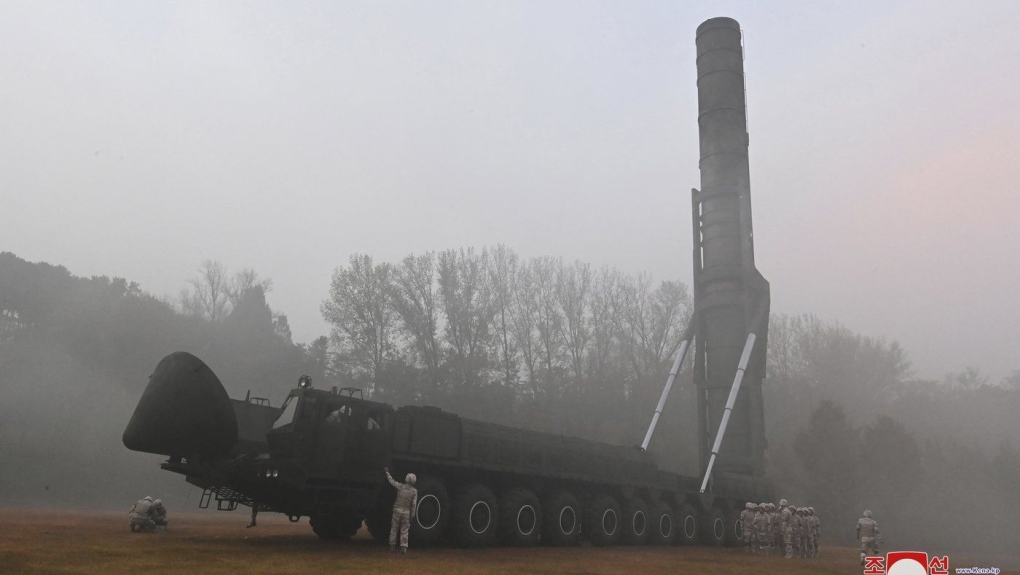North Korea Claims ‘World’s Strongest’ ICBM, But Experts See Hurdles in Nuclear Missile Development
Seoul, South Korea – North Korea declared on Friday that its latest intercontinental ballistic missile (ICBM) test showcases “the world’s strongest” missile, although international experts suggest this is largely propaganda. The test on Thursday marked progress in North Korea’s efforts to develop a reliable nuclear-armed ICBM that could potentially reach the U.S. mainland. However, foreign analysts believe North Korea still faces technical challenges before achieving a fully functional long-range missile.
VIRGINIA Voters Removed From Rolls After Supreme Court Ruling!
Kim Jong Un Unveils North Korea’s ‘Most Advanced’ Missile Amid Rising Security Tensions
According to North Korea’s Korean Central News Agency (KCNA), the new missile, called “Hwasong-19,” is their most advanced weapon yet, with leader Kim Jong Un present at the test launch. Kim described it as a “strategic” response to perceived threats against North Korea’s security, thanking scientists for showcasing the country’s “unmatched strategic nuclear capability.”
The South Korean military indicated that the missile might use solid fuel, a factor which allows faster, harder-to-detect launches. Although KCNA did not specify the propellant type, experts believe images of the launch indicate the Hwasong-19 ICBM does use solid fuel.
Previously, North Korea’s most advanced ICBM was the Hwasong-18, also a solid-fuel missile. Solid propellants are advantageous because they allow missiles to be pre-loaded, reducing the time and visibility of launch preparations, unlike liquid-fueled missiles that require extensive setup.
Experts Question North Korea’s Ability to Reach U.S. with Nuclear Missiles Despite Regional Threats
North Korea has claimed continuous improvements in nuclear capabilities, and many experts believe it now has missiles that could reach targets across South Korea. However, questions remain about its capacity to deliver missiles capable of reaching the U.S. mainland. For a fully operational ICBM, North Korea would need to master warhead re-entry technology and advanced guidance systems, potentially even the ability to carry multiple warheads to outmaneuver missile defenses.
To avoid alarming neighboring countries, North Korea launched the missile at a high angle, limiting its range. According to South Korea’s defense officials, this method prevents confirmation of the missile’s re-entry abilities, despite North Korean claims of possessing such technology.

This photo, released by the North Korean government, reportedly shows the test launch of the new intercontinental ballistic missile “Hwasong-19” at an undisclosed location in North Korea on Thursday, Oct. 31, 2024. Independent journalists were not permitted to cover the event shown in this government-distributed image, and its content cannot be independently verified. The Korean-language watermark on the image reads “KCNA,” indicating it is from the Korean Central News Agency. (Korean Central News Agency/Korea News Service via AP)
North Korea’s ICBM Test Seen as Strategic Move Amid U.S. Election and Deepening Ties with Russia
Observers suggest that the timing of this test, North Korea’s first ICBM launch in nearly a year, is meant to draw U.S. attention ahead of the presidential election. North Korea also faces international criticism for reportedly sending troops to support Russia’s war in Ukraine, underscoring its deepening alliance with Moscow.
This support raises concerns in South Korea, the U.S., and beyond, with speculation that North Korea may seek advanced Russian technology to enhance its own nuclear and missile programs in exchange for its involvement in the conflict.






It’s really a nice and useful piece of information. I am glad that you shared this helpful info with us. Please keep us up to date like this. Thanks for sharing.
Thank you for your kind feedback! I’m so glad to hear that you found the information helpful and useful. It’s always my goal to share content that adds value to my readers. 😊
I’ll definitely keep sharing updates and helpful insights, so stay tuned for more! If there’s anything specific you’d like me to cover, feel free to let me know—I’d love to hear your suggestions.
Thanks again for stopping by and for your support!
I do consider all the concepts you’ve introduced to your post. They are very convincing and will certainly work. Still, the posts are very brief for starters. May just you please extend them a bit from subsequent time? Thank you for the post.
I really appreciate your feedback! 😊 I’m glad you find the concepts convincing. I’ll definitely keep your suggestion in mind and work on making future posts more detailed and comprehensive. Thanks for your support, and feel free to share any specific topics you’d like to see expanded! 🚀
Can you be more specific about the content of your article? After reading it, I still have some doubts. Hope you can help me.
Can you be more specific about the content of your article? After reading it, I still have some doubts. Hope you can help me.
Thank you for reading. Could you please be more specific?